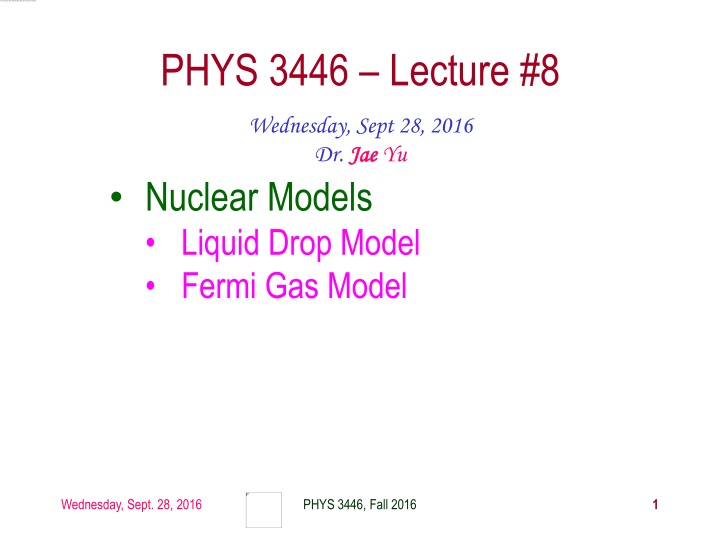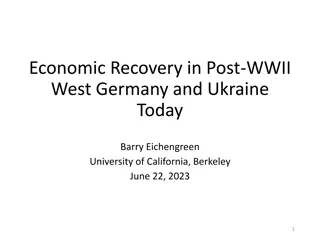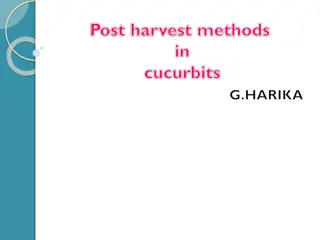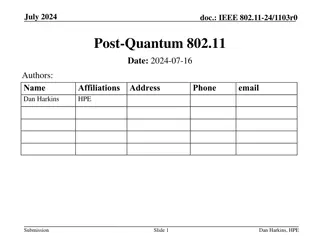
Nuclear Models: Liquid Droplet Model and Fermi Gas Model
Explore the concepts of Nuclear Models through the Liquid Droplet Model and the Fermi Gas Model. Understand the structure of the nucleus, nuclear forces, and the interplay of nucleons within it. Dive into the world of nuclear physics with this comprehensive study.
Download Presentation

Please find below an Image/Link to download the presentation.
The content on the website is provided AS IS for your information and personal use only. It may not be sold, licensed, or shared on other websites without obtaining consent from the author. If you encounter any issues during the download, it is possible that the publisher has removed the file from their server.
You are allowed to download the files provided on this website for personal or commercial use, subject to the condition that they are used lawfully. All files are the property of their respective owners.
The content on the website is provided AS IS for your information and personal use only. It may not be sold, licensed, or shared on other websites without obtaining consent from the author.
E N D
Presentation Transcript
PHYS 3446 Lecture #8 Wednesday, Sept 28, 2016 Dr. Jae Jae Yu Nuclear Models Liquid Drop Model Fermi Gas Model Wednesday, Sept. 28, 2016 PHYS 3446, Fall 2016 1
Announcement First term exam Date and time: 2:30 3:50pm, Monday, Oct. 10 Location: SH125 Covers: Ch 1 Ch 3 or what we finish Wednesday, Oct. 5, + Appendix A Can bring your calculator but no phone or computer can be used as a replacement Colloquium Dr. Amir Farbin on Deep Learning Wednesday, Sept. 28, 2016 PHYS 3446, Fall 2016 2
Wednesday, Sept. 28, 2016 PHYS 3446, Fall 2016 3
Reminder: Homework Assignment #4 1. Compute the mass density of a nucleus (10points) Pick two nuclei for this. I would like you guys to do different ones. 2. Compute the de Broglie wavelengths for (15 points) Protons in Fermilab s Tevatron Collider Protons in CERN s Large Hadron Collider (LHC) 500 GeV electrons in the International Linear Collider 3. Compute the actual value of the nuclear magneton (5 points) Due for the above is next Monday, Oct. 3 Wednesday, Sept. 28, 2016 PHYS 3446, Fall 2016 4
Nuclear Models Experiments showed very different characteristics of nuclear forces than other forces Quantification of nuclear forces and the structure of nucleus were not straightforward Fundamentals of nuclear force were not well understood Several phenomenological models (not theories) that describe only limited cases of experimental findings Most the models assume central potential, just like the Coulomb potential Wednesday, Sept. 28, 2016 PHYS 3446, Fall 2016 5
Nuclear Models: Liquid Droplet Model An earliest phenomenological success in describing binding energy of a nucleus (George Gamow) Nucleus is essentially spherical with radius proportional to A1/3. Densities are independent of the number of nucleons Led to a model that envisions the nucleus as an incompressible liquid droplet In this model, nucleons are equivalent to molecules Quantum properties of individual nucleons are ignored Wednesday, Sept. 28, 2016 PHYS 3446, Fall 2016 6
Nuclear Models: Liquid Droplet Model Nucleus is imagined to consist of A stable central core of nucleons where nuclear force is completely saturated A surface layer of nucleons that are not bound tightly This weaker binding at the surface decreases the effective BE per nucleon (B/A) Provides an attraction of the surface nucleons towards the core just as the surface tension Wednesday, Sept. 28, 2016 to the liquid would PHYS 3446, Fall 2016 7
Liquid Droplet Model: Binding Energy If a constant BE per nucleon is due to the saturation of the nuclear force, the nuclear BE can be written as: BE = 2 3 + 2a A 1a A What do you think each term does? First term: volume energy for uniform saturated binding Second term corrects for weaker surface tension This can explain the low BE/nucleon behavior of low A nuclei For low A nuclei, the proportion of the second term is larger. Reflects relatively large number of surface nucleons than the core. Wednesday, Sept. 28, 2016 PHYS 3446, Fall 2016 8
Liquid Droplet Model: Binding Energy Small decrease of BE for heavy nuclei can be understood as due to the Coulomb repulsion The electrostatic energies of protons have a destabilizing effect Reflecting this effect, the empirical formula for BE takes a new correction term BE = 3a Z A 2 3 2 1 3 a A a A + + 1 2 Each term of this formula has a classical origin. This formula does not explain Lighter nuclei with the equal number of protons and neutrons are stable or have a stronger binding (larger BE) Natural abundance of stable even-even nuclei or paucity of odd- odd nuclei These could mainly arise from quantum effect of spins. Wednesday, Sept. 28, 2016 PHYS 3446, Fall 2016 9
Liquid Droplet Model: Binding Energy Additional corrections to compensate the deficiency, give corrections to the empirical formula (again ) ( ) 2 N Z 5a A 3 4 + a Z A a 2 3 2 1 3 = a A a A + + BE 4 1 2 3 A All parameters are assumed to be positive The forth term reflects N=Z stability The last term Positive sign is chosen for odd-odd nuclei, reflecting instability Negative sign is chosen for even-even nuclei For odd-A nuclei, a5 is chosen to be 0 since BE can be described well for these nuclei without this term Wednesday, Sept. 28, 2016 PHYS 3446, Fall 2016 10
Liquid Droplet Model: Binding Energy The parameters are determined by fitting experimentally observed BE for a wide range of nuclei: 15.6 a MeV 2 16.8 a 23.3 a MeV 0.72 ; MeV a a MeV 1 3 34 MeV 5 4 Now we can write an empirical formula for masses of nuclei ( ) ( ) , n p M A Z A Z m Zm = + BE c a c = ( ( N ) A Z m ) Z A + + Zm n p 2 2 aA c aZ A c a c a c 1 3 3 4 1 2 2 2 3 + + + 3 2 5 2 2 2 4 2 A A This is Bethe-Weizsacker semi-empirical mass formula (1935) Used to predict stability and masses of unknown nuclei of arbitrary A and Z Wednesday, Sept. 28, 2016 PHYS 3446, Fall 2016 11






















